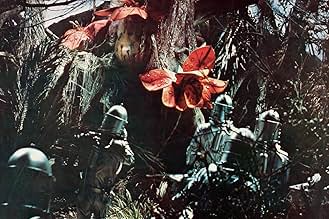IMDb-BEWERTUNG
6,2/10
338
IHRE BEWERTUNG
Füge eine Handlung in deiner Sprache hinzuA scientist fears that the prophecies of Nostradamus, including the end of all life on Earth, are coming true one after another.A scientist fears that the prophecies of Nostradamus, including the end of all life on Earth, are coming true one after another.A scientist fears that the prophecies of Nostradamus, including the end of all life on Earth, are coming true one after another.
Kyôko Kishida
- Narrator
- (Synchronisation)
Empfohlene Bewertungen
Oh, what a wonderful movie!!!! I loved it!!! Ok, special effects are a little weak, but the script was terrific!!!
10Kabumpo
This film is so powerful that it was successfully banned in its native country. Unfortunately, horrible dubbing and sound mix, commercial fade-outs and other tampering have cheapened the film into only a hint of its original brilliance. The film sports a unique score by Isao Tomita, which, for me, defines the essence of decline in the penultimate year of the 20th century we are now in. Unfortunately, bad choices in American narration cause erratic volume changes which decrease the effect. Critics attacked it for the distinctly seventies fashions which are, as predicted, back in vogue. The film was actually not written by Yasumi, but updated from his script for _Sekai Daisenso_ (_The Last War_) and credited to him out of respect. Perhaps if the film, which is minimal on narrative and seems a forerunner to the work of Godfrey Reggio, were given a widescreen and subtitled reissue (and what better time than this year), respect for the film would increase. It pulls out all the stops with disasters, including the pestilence of giant slugs (which are simply giant slugs, like though that plague India, not flesh-eating or blood-eating as detractors of the film would like you to believe) and plants that tear through subways (and no, they do not eat people as some reviews claim). Nature takes things back from the city, young people find solace in random sex, wanton drug use, and suicide. Traffic jams wreak havoc as people get out of control, food rations are torn away as people believe there are shortages, while luxury beef diets continue, and Nishiyama believes they are all related to the prophecies of Nostradamus. Bizarre effects ensue, like snow on the pyramids, and people's highest morals are challenged. What we have is a work of cinematic brilliance torn apart by an American distributor until what results becomes fodder for MST3K. Know what neurofibromatosis looks like?
I think the main reason a lot of folks look at Last Days of Planet Earth as a bad movie is that it really is a "message" picture...and a Japanese message picture at that. Message pictures really don't hold up well outside the era they were filmed in.
The early seventies were filled with doom & gloom films like this...look at Toho's own Godzilla Vs. the Smog Monster. This movie is wreathed in the prophecies of Nostradamus as well, so you can fit a whole lot of "message" in.
The film has a lot of good shots and some good SFX (the reflected city and the final apocalyptic scene are both well executed), but the US dialogue track makes the whole thing sound pretty lame. I'd love to see a subtitled version of it to see what the picture really was supposed to be about.
The early seventies were filled with doom & gloom films like this...look at Toho's own Godzilla Vs. the Smog Monster. This movie is wreathed in the prophecies of Nostradamus as well, so you can fit a whole lot of "message" in.
The film has a lot of good shots and some good SFX (the reflected city and the final apocalyptic scene are both well executed), but the US dialogue track makes the whole thing sound pretty lame. I'd love to see a subtitled version of it to see what the picture really was supposed to be about.
I remember seeing Catastrophe 1999: Prophecy of Nostradamus (or on Brasil TV, Catástrofe: Palavra do Nostradamus) when I was a little kid, and every time something happened, like Mutants on the attack or cataclysms would happen, I remembered running from the room, screeching at the top of my lungs, heading for my bedroom closet! I swear, my sister is sucha psyco for showing me this film when I was at an under ripe early age.
Forget Stephen King! I think the people whom worked on Catastrophe 1999 could just be a great creep out, despite some dated themes..... ...whew, that was a bit melodramatic *heh heh*
Forget Stephen King! I think the people whom worked on Catastrophe 1999 could just be a great creep out, despite some dated themes..... ...whew, that was a bit melodramatic *heh heh*
10dotdman
Nostrodamusu no Daiyogen was released originally in 1974 and subsequently banned in its homeland due to two scenes graphically depicting the aftermath of radiation exposure. The Japanese censors thought that the two scenes were far to reminiscent of the Hiroshima bombing to be seen by the public at large. Toho has since disowned the title, which has never been legitimately released in its original and unaltered form.
Catastrophe 1999, the international version of the film, was played in Europe and elsewhere. The film was cut from 114 minutes to 85, mostly removing important characterization scenes and the heartfelt speech of the Japanese Prime Minister that occurs in the final minutes of the film. This cut is still available on VHS in some European nations, but is hard to come by.
In the 1980's, Harry Saperstein (responsible for the US television releases of films like War of the Gargantuas and Frankenstein Conquers the World) got a hold of a print and butchered it into a cut several minutes longer than the international version (88 minutes) but lacking even more of the important scenes in the film. The original introduction was recut beyond repair, most of the references to Nostradamus and his prophecies were removed, and a makeshift ending was tacked on that minced scenes from the original Japanese ending and other parts of the film together. Paramount released a VHS and laserdisc of this version under the title The Last Days of Planet Earth and it is still played on television occassionally.
Thankfully for fans of Japanese cinema, someone located an unadulterated timecoded print of the film and has since made the original 114 minute version available, albeit only in Japan. I managed to snare a copy through an import service. The differences are astounding. Gone is the choppy editing of the international and US versions of the film, vanished is the dubbing, and what's left is one of the finest Japanese disaster films of all time. I can say for a fact that those of you who have only seen the Last Days of Planet Earth or Catastrophe 1999 prints of the film have, in fact, not seen the film at all. Judging the film by watching these butchered versions is not only difficult, but nearly impossible.
I encourage anyone with interest in the film to locate a copy of the 114 minute cut. It may not be for everyone, but those that even slighly enjoyed either of the cut versions are sure to find infinitely more to enjoy in the original Japanese version.
Catastrophe 1999, the international version of the film, was played in Europe and elsewhere. The film was cut from 114 minutes to 85, mostly removing important characterization scenes and the heartfelt speech of the Japanese Prime Minister that occurs in the final minutes of the film. This cut is still available on VHS in some European nations, but is hard to come by.
In the 1980's, Harry Saperstein (responsible for the US television releases of films like War of the Gargantuas and Frankenstein Conquers the World) got a hold of a print and butchered it into a cut several minutes longer than the international version (88 minutes) but lacking even more of the important scenes in the film. The original introduction was recut beyond repair, most of the references to Nostradamus and his prophecies were removed, and a makeshift ending was tacked on that minced scenes from the original Japanese ending and other parts of the film together. Paramount released a VHS and laserdisc of this version under the title The Last Days of Planet Earth and it is still played on television occassionally.
Thankfully for fans of Japanese cinema, someone located an unadulterated timecoded print of the film and has since made the original 114 minute version available, albeit only in Japan. I managed to snare a copy through an import service. The differences are astounding. Gone is the choppy editing of the international and US versions of the film, vanished is the dubbing, and what's left is one of the finest Japanese disaster films of all time. I can say for a fact that those of you who have only seen the Last Days of Planet Earth or Catastrophe 1999 prints of the film have, in fact, not seen the film at all. Judging the film by watching these butchered versions is not only difficult, but nearly impossible.
I encourage anyone with interest in the film to locate a copy of the 114 minute cut. It may not be for everyone, but those that even slighly enjoyed either of the cut versions are sure to find infinitely more to enjoy in the original Japanese version.
Wusstest du schon
- WissenswertesSince this was a full-scale production, Toho required the use of all of their own visual effects soundstages. However, during filming of a special effects scene, a pyrotechnical accident caused a fire that burned down part of the main visual effects soundstage, an incident that was very widely reported in Japan at the time. The fire destroyed a number of costumes and props from earlier Toho tokusatsu classics that were kept in storage at the time, including the original Mogera costume from Weltraumbestien (1957).
- Crazy CreditsClosing title card reads: The story you have just seen was a work of fiction. The events it portrayed, however, may take place in our world. It's up to you to take action to ensure the these events do not come to pass...
- Alternative VersionenThere are three versions of Nosutoradamusu no daiyogen that are known to exist:
- The original Japanese release, "Nosutoradamusu no daiyogen" (literal translation: "Great Prophecies of Nostradamus", which ran at about 114 minutes. After the film was banned in Japan, this version was only shown once on Japanese television in the early 1980's and has since been unavailable except by obtaining copies via the grey market.
- The second version, titled "Catastrophe 1999: Prophecies of Nostradamus" was an English-dubbed variant of "Nosutoradamusu no daiyogen", but was shorn of some 25 minutes of footage. The excised footage consisted of mainly dialogue scenes, but the original prologue and ending were trimmed greatly or excised altogether. The only known release of this variant is a long out-of-print Danish video release, which runs at about 90 minutes (PAL speed).
- The third, and possibly most familiar variant is titled "The Last Days of Planet Earth". This version was for American television showings and was prepared by United Productions of America. For this particular release, the film was cut even further. It actually added an annoying narrator commenting on the events, replacing the original accompanying female voice reading from Nostradamus' predictions. It is this version that has been circulating on video and TV in the United States. Running time: 88 minutes (without commercials)
- VerbindungenEdited into Godzilla - Die Rückkehr des Monsters (1984)
Top-Auswahl
Melde dich zum Bewerten an und greife auf die Watchlist für personalisierte Empfehlungen zu.
- How long is Prophecies of Nostradamus?Powered by Alexa
Details
- Erscheinungsdatum
- Herkunftsland
- Sprachen
- Auch bekannt als
- Prophecies of Nostradamus
- Drehorte
- Tokio, Japan(location filming, interiors and exteriors)
- Produktionsfirmen
- Weitere beteiligte Unternehmen bei IMDbPro anzeigen
- Laufzeit1 Stunde 54 Minuten
- Sound-Mix
- Seitenverhältnis
- 2.35 : 1
Zu dieser Seite beitragen
Bearbeitung vorschlagen oder fehlenden Inhalt hinzufügen































